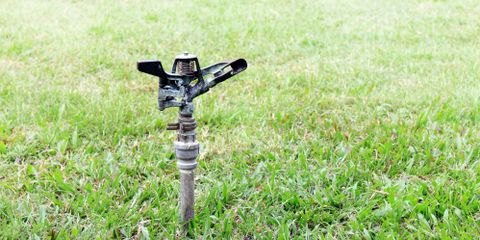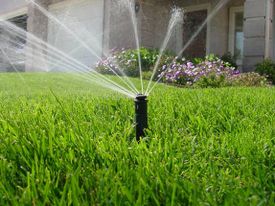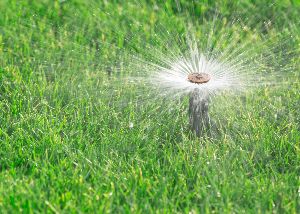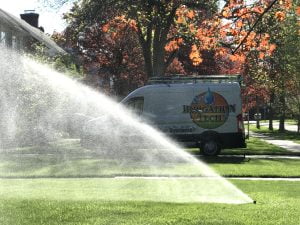The best way to ensure that your lawn is lush and green all spring, summer, and fall is to install an automatic lawn irrigation system. An automatic lawn irrigation system is fed from property’s water supply – or a nearby lake, pond, or well, and is operated by computerized controller that you can ‘set and forget,’ adjust occasionally, or if WiFi enabled, operate remotely. If the irrigation system is fed from a potable (drinking) water supply, New York State requires a backflow prevention device to be installed between the water supply and the irrigation system supply.
There are two basic types of water-efficient irrigation systems that can be combined to fit the unique needs of your property – and save you time as well as the hassle of hand or hose watering.
 1. Drip Irrigation – for shrubs, planting beds and gardens
1. Drip Irrigation – for shrubs, planting beds and gardens
A water-efficient drip irrigation system for shrubbery, vegetable gardens, and flower beds sends a steady, controlled flow of moisture straight to the roots of your plants. This system is typically made up of a series of thin, flexible, perforated tubes or flexible, permeable soaker hose lines installed under the mulch or just below the surface of the soil.
Surface drip irrigation systems involve tubes that rest on top of the soil. These systems are very adaptable and are typically used in garden settings.
Subsurface systems are buried out-of-sight and slowly drip water out near roots within the soil, and less adaptable than surface systems.
Because drip irrigation systems are placed on or in the soil, the water they supply is immediately delivered to the parts of the plant that need them most—the roots. This direct application reduces the risk of evaporation and allows for better absorption to promote healthy plant growth. It also helps limit the growth of invasive, destructive organisms, including weeds and fungi.
 2. Sprinkler Irrigation – for lawns and large planting areas
2. Sprinkler Irrigation – for lawns and large planting areas
Sprinkler systems used to cover broad and irregular lawn areas, and sometimes large planting beds. They eliminate the time, hassle, and hard work required for ‘hose management’. Sprinkler heads mimic rainfall by spraying water into the air and letting it fall on the grass. Pop-up sprinkler heads retract into the ground so that when not in use they cannot easily be damaged by mowing and landscaping equipment.
Drip Irrigation – Benefits
Hand watering shrubs, planting beds and gardens is a time-consuming, and imprecise process that can damage plants.
Drip irrigation distributes water precisely and evenly to shrubs, planting beds, and gardens. Here are five good reasons to install or upgrade to a drip irrigation.
1. Improves Growth
By targeting specific zones, drip irrigation can provide water to plant roots in a way that’s more direct, controlled, and appropriate than a sprinkler system. As a result, you can expect your plants to get the right amount of water and nutrients they need to thrive.
2. Prevents Overwatering and Reduces Water Waste
Because drip irrigation delivers water directly to the base of plantings, there is less potential for evaporation and as a result, drip irrigation uses considerably less water than irrigating with spray or sprinkler heads.
3. Keeps Weeds at Bay
Weeds don’t need much water or sunlight to grow. If you use a drip irrigation system, you are doing everything you can to make sure that these plants aren’t getting additional moisture provided by you. Over time, after installing a drip system, you can expect the weed population to decrease while your trees and shrubs become even more healthy.
4. Prevents Overwatering and Root Rot
When plants are overwatered – either by hand or by a sprinkler system, they can become waterlogged. If moisture is present for too long, roots can rot. If the roots aren’t healthy, plants can develop yellow leaves, experience slow or limited growth, or even die off. Drip irrigation helps prevent these undesired outcomes by providing controlled and targeted water at specific intervals so overwatering doesn’t occur.
5. Defends Against Fungal Growth
Mold and other fungi grow rapidly if they are exposed to increased moisture and heat. In addition to taking over mulch beds and lawns, these fungal infestations can contribute to a variety of plant diseases that cause discoloration, spotting, and decay. With drip irrigation, moisture levels remain low, yet consistent, to help prevent fungal growth.
Sprinkler Irrigation – Benefits
Hose management is a hassle – and unwinding, dragging, and rewinding hoses can be a hard, hot, dirty, time-consuming – and never-ending- chore that doesn’t deliver the desired results.
Sprinkler irrigation distributes water effortlessly, efficiently, and evenly over irregular or large lawn and planting areas. There are several types of sprinkler heads, some older, some newer, that may have been used in a system that will be modified or expanded by us. For expansions, replacements, and new installations we will use the newer models to save water and promote healthier landscapes.
Most newer systems use a head that pops up to irrigate when it cycles on and then retracts into a housing below the ground when the cycle is complete. Some old systems, or systems designed to cover very large areas, may employ sprinkler heads on stationary risers that are permanently above ground. If you have an older system with pop-up heads, it’s a good idea to consider replacing them with newer, water-saving models because they do a better job of distributing water, operate more reliably, and will improve the health of your landscape.
Sprinkler Irrigation – Types of Heads & Uses
Older Head Types
1. Fixed Impact Rotor Heads

2. Stationary Spray Heads

Stationary (fixed) spray heads are available in a variety of heights and spray a mist in a full or partial circular pattern, to cover a bigger area or a specific area (e.g., watering the lawn, not the nearby sidewalk). Spray head precipitation rates deliver more water per square foot than rotor heads and have been used on thirsty landscape areas.
3. Pop-up Impact-Driven Rotors

Pop-up impact-driven rotor heads move in a full or partial circular pattern to deliver a steady stream of water over a long radius. Depending on the size of the head – and the available water pressure, impact-driven rotor heads can throw water up to 100 feet.
Newer Pop-up Sprinkler Heads
1. Stream Rotors – better and more efficient than stationary spray heads

Stream rotor heads move in a full or partial circular pattern with a coverage radius as short as eight feet. Stream rotor precipitation rates have distribution uniformities equal to or better than large turf rotors. They eliminate the problem with spray heads that put down water faster than many types of soils can absorb it. With stream heads, all of the water gets into the soil instead of laying on the surface, running off, or evaporating into the air. The stream rotor’s high distribution uniformities also eliminate wet and dry areas that can be created by spray heads.
2. Gear-Driven Rotors – better and more efficient than impact-driven rotors


Gear-driven rotor heads, like the older impact-driven models, can move in a full or partial circular pattern, can achieve wide coverage areas, and have similar precipitation rates. Where they differ from noisy impact-driven heads is that they are quieter and function more reliably because they are less likely to become clogged by lawn debris.
When it’s time to start-up, reset, inspect, repair, refurbish, upgrade, expand, replace, or winterize your lawn sprinkler system, turn to the professionals at Irrigation Tech in Pittsford, NY. Their team of irrigation experts has been installing and servicing high-quality residential and commercial systems throughout Monroe County and The Finger Lakes Region for nearly 40 years. They’re fully certified backflow prevention specialists who can ensure you have access to the latest innovations in irrigation systems and quality installation. They’ve also been chosen by the Irrigation Association twice as one of the Top 100 Contractors in the country. To learn more about the Irrigation Tech team, visit our website or call (877) 8-IRRIGATE to speak with a customer service representative.


 1. Drip Irrigation – for shrubs, planting beds and gardens
1. Drip Irrigation – for shrubs, planting beds and gardens 2. Sprinkler Irrigation – for lawns and large planting areas
2. Sprinkler Irrigation – for lawns and large planting areas